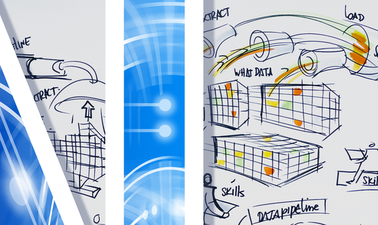Description
Learn how to create, evaluate, and integrate predictive models that have the potential to change patient outcomes. Begin by classifying and segmenting 2D and 3D medical images to help with diagnosis, and then progress to modelling patient outcomes using electronic health records to help with clinical trial testing decisions. Finally, create an algorithm that estimates the wearer's pulse rate in the presence of motion using data collected from wearable devices.
Syllabus:
Course 1: Applying AI to EHR Data
EHR Data Security and Analysis
- Understand U.S. healthcare data security and privacy best practices (e.g. HIPAA, HITECH) and how they affect utilizing protected health information (PHI) data and building models
- Analyze EHR datasets to check for common issues (data leakage, statistical properties, missing values, high cardinality) by performing exploratory data analysis
EHR Code Sets
- Understand the usage and structure of key industry code sets (ICD, CPT, NDC).
- Group and categorize data within EHR datasets using code sets.
EHR Transformations & Feature Engineering
- Use the Tensorflow Dataset API to scalably extract, transform, and load datasets
- Build datasets aggregated at the line, encounter, and longitudinal(patient) data levels
- Create derived features (bucketing, cross-features, embeddings) utilizing Tensorflow feature columns on both continuous and categorical input features
Building, Evaluating, and Interpreting Models
- Analyze and determine biases for a model for key demographic groups by evaluating performance metrics across groups by using the Aequitas framework.
- Train a model that provides an uncertainty range with the Tensorflow Probability library
- Use Shapley values to select features for a model and identify the marginal contribution for each selected feature
Project: Patient Selection for Diabetes Drug Testing
EHR data is quickly becoming a critical source of real-world evidence (RWE) for the pharmaceutical industry and regulators making clinical trial decisions. You will work as a data scientist for an exciting unicorn healthcare startup that has developed a groundbreaking diabetes drug that is ready for clinical trial testing.Your task will be to create a regression model that predicts a patient's estimated hospitalisation time in order to help select/filter patients for your study. First, you will conduct exploratory data analysis to determine the dataset level and feature selection. Following that, you will use Tensorflow to create the necessary categorical and numerical feature transformations. Finally, you will create a model and use various analysis frameworks, such as Tensorflow Probability and Aequitas, to assess model bias and uncertainty.
Course 2: Applying AI to 2D Medical Imaging Data
Introduction to AI for 2D Medical Imaging
- Explain what AI for 2D medical imaging is and why it is relevant.
Clinical Foundations of 2D Medical Imaging
- Learn about different 2D medical imaging modalities and their clinical applications
- Understand how different types of machine learning algorithms can be applied to 2D medical imaging
- Learn how to statistically assess an algorithm’s performance
- Understand the key stakeholders in the 2D medical imaging space .
2D Medical Imaging Exploratory Data Analysi
- Learn what the DICOM standard it is and why it exists
- Use Python tools to explore images extracted from DICOM files
- Apply Python tools to explore DICOM header data
- Prepare a DICOM dataset for machine learning
- Explore a dataset in preparation for machine learning
Classification Models of 2D Medical Images
- Understand architectures of different machine learning and deep learning models, and the differences between them
- Split a dataset for training and testing an algorithm
- Learn how to define a gold standard
- Apply common image pre-processing and augmentation techniques to data
- Fine-tune an existing CNN architecture for transfer learning with 2D medical imaging applications
- Evaluate a model’s performance and optimize its parameters
Translating AI Algorithms for Clinical Settings with the FDA
- Learn about the FDA’s risk categorization for medical devices and how to define an Intended Use statement
- Identify and describe algorithmic limitations for the FDA
- Translate algorithm performance statistics into clinically meaningful information that can trusted by professionals
- Learn how to create an FDA validation plan
Project: Pneumonia Detection from Chest X-Rays
Chest X-rays are one of the most common and cost-effective types of medical imaging tests. Even for experienced radiologists, determining clinical diagnoses from chest X-rays can be difficult. Chest X-rays are the best available method for point-of-care diagnosis of pneumonia. Every year, more than 1 million adults are hospitalised with pneumonia, and approximately 50,000 people die from the disease in the United States alone. Pneumonia's high prevalence makes it an ideal candidate for the development of a deep learning application for two reasons: 1) A sufficient amount of data is available for training deep learning models for image classification. 2) Clinical assistance by providing higher accuracy image reads of a difficult-to-diagnose disease and/or clinical burnout reduction by performing automated reads of very common scans. In this project, you will analyse data from the NIH Chest X-ray dataset and train a CNN to detect the presence or absence of pneumonia in a given chest X-ray. First, you'll select training and testing sets from a large collection of medical images that are relevant to the clinical question at hand.Then, you'll build a pipeline to extract images from DICOM files and feed them into the CNN for model training. Finally, you will write an FDA 501(k) validation plan that formally describes your model, the data on which it was trained, and a validation plan that meets FDA criteria in order to obtain clearance of the software being used as a medical device.
Course 3: Applying AI to 3D Medical Imaging Data
Introduction to AI for 3D Medical Imaging
- Explain what AI for 3D medical imaging is and why it is relevant
3D Medical Imaging - Clinical Fundamentals
- Identify medical imaging modalities that generate 3D images
- List clinical specialties who use 3D images to influence clinical decision making
- Describe use cases for 3D medical images • Explain the principles of clinical decision making
- Articulate the basic principles of CT and MR scanner operation
- Perform some of the common 3D medical image analysis tasks such as windowing, MPR and 3D reconstruction
3D Medical Imaging Exploratory Data Analysis
- Describe and use DICOM and NIFTI representations of 3D medical imaging data
- Explain specifics of spatial and dimensional encoding of 3D medical images
- Use Python-based software packages to load and inspect 3D medical imaging volumes
- Use Python-based software packages to explore datasets of 3D medical images and prepare it for machine learning pipelines
- Visualize 3D medical images using open software packages
3D Medical Imaging - Deep Learning Methods
- Distinguish between classification and segmentation problems as they apply to 3D imaging
- Apply 2D, 2.5D and 3D convolutions to a medical imaging volume
- Apply U-net algorithm to train an automatic segmentation model of a real-world CT dataset using PyTorch
- Interpret results of training, measure efficiency using Dice and Jaccard performance metrics
Deploying AI Algorithms in the Real World
- Identify the components of a clinical medical imaging network and integration points as well as DICOM protocol for medical image exchange
- Define the requirements for integration of AI algorithms
- Use tools for modeling of clinical environments so that it is possible to emulate and troubleshoot real-world AI deployments
- Describe regulatory requirements such as FDA medical device framework and HIPAA required for operating AI for clinical care
- Provide input into regulatory process, as a data scientist
Project: Hippocampal Volume Quantification in Alzheimer’s Progression
The hippocampus is a major structure of the human brain with functions primarily related to learning and memory. The hippocampus's volume can change over time, with age, or as a result of disease. A 3D imaging technique with good soft tissue contrast is required to measure hippocampal volume. Although MRI provides such imaging characteristics, manual volume measurement still necessitates the careful and time-consuming delineation of the hippocampal boundary. In this project, you will go through the steps of developing an algorithm that will assist clinicians in assessing hippocampal volume in an automated manner, as well as integrating this algorithm into a clinician's working environment. First, you'll create a hippocampal image dataset to train the U-net-based segmentation model on, and then you'll measure performance on test data. The machine learning execution code will then be connected to a clinical network, code will be written to generate reports based on the algorithm output, and results will be inspected in a medical image viewer. Finally, you will create a validation plan to aid in the collection of clinical evidence of the algorithm's performance, as required by regulatory authorities.
Course 4: Applying AI to Wearable Device Data
Intro to Digital Sampling & Signal Processing
- Describe how to digitally sample analog signals
- Apply signal processing techniques (eg. filtering, resampling, interpolation) to time series signals.
- Apply frequency domain techniques (eg. FFT, STFT, spectrogram) to time series signals
- Use matplotlib’s plotting functionality to visualize signals
Introduction to Sensors
- Describe how sensors convert a physical phenomenon into an electrical one.
- Understand the signal and noise characteristics of the IMU and PPG signals
Activity Classification
- Perform exploratory data analysis to understand class imbalance and subject imbalance
- Gain an intuitive understanding signal characteristics and potential feature performance
- Write code to implement features from literature
- Recognize the danger overfitting of technique (esp. on small datasets), not simply of model parameters or hyperparameters
ECG Signal Processing
- Understand the electrophysiology of the heart at a basic level
- Understand the signal and noise characteristics of the ECG
- Understand how atrial fibrillation manifests in the ECG
- Build a QRS complex detection algorithm
- Build an arrhythmia detection algorithm from a wearable ECG signal
- Understand how models can be cascaded together to achieve higher-order functionality
Project: Motion Compensated Pulse Rate Estimation
Wearable devices contain multiple sensors that all collect data about the same person at the same time. By combining these data streams, we can perform many tasks that would be impossible with a single sensor. In this project, you will create an algorithm that combines data from two of the sensors covered in this course, the IMU and PPG sensors, to estimate the wearer's pulse rate in the presence of motion.
First, you'll build signal processing features and a random forest model to create and test an activity classification algorithm. Then you'll create a pulse rate algorithm that employs the activity classifier and frequency domain techniques, as well as an associated confidence metric that estimates the accuracy of the pulse rate estimate. Finally, you will evaluate algorithm performance and iterate on design until you achieve the desired accuracy.









